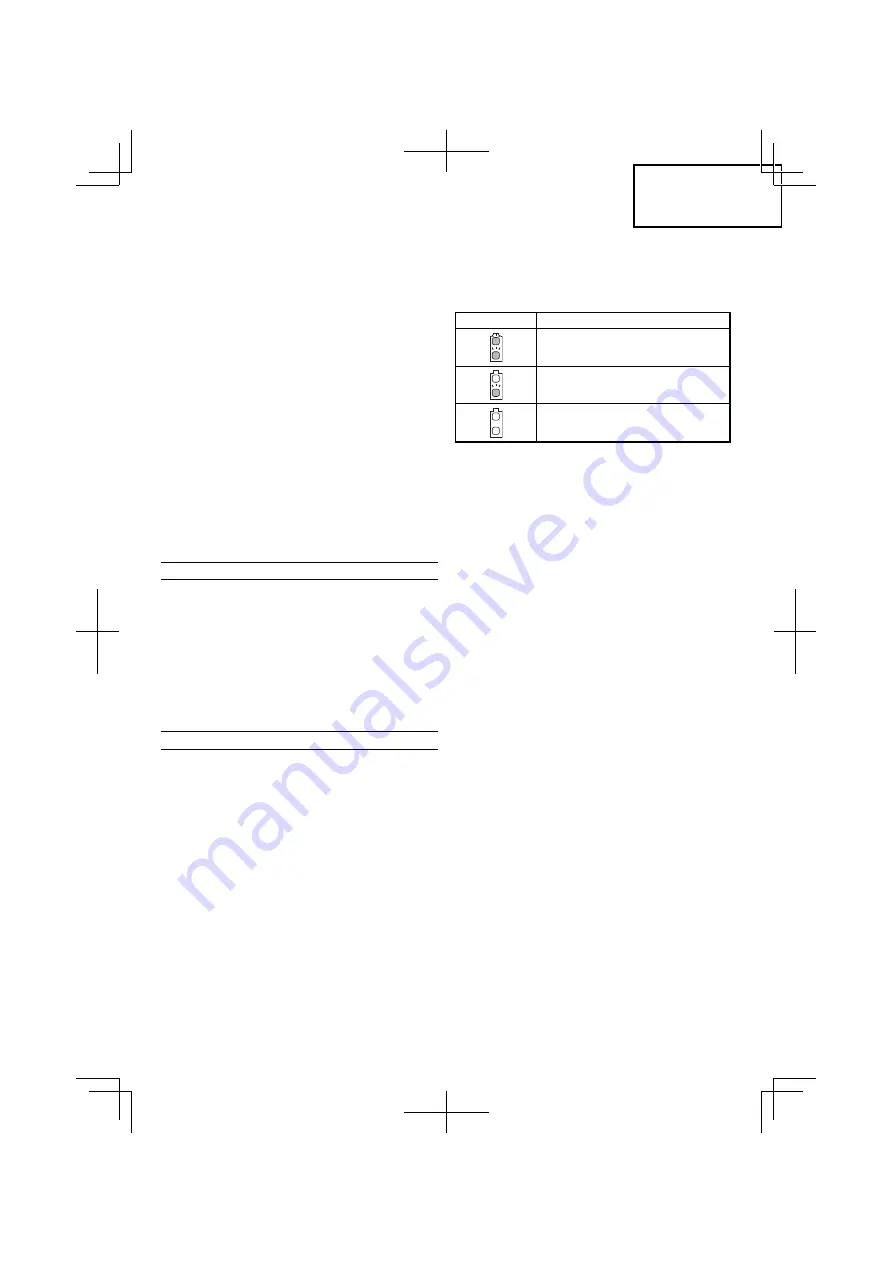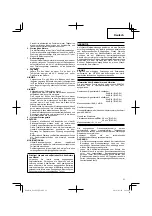
English
19
CAUTION
○
If the battery is charged while it is heated because it has
been left for a long time in a location subject to direct
sunlight or because the battery has just been used, the
pilot lamp of the charger lights for 1 second, does not
light for 0.5 seconds (o
ff
for 0.5 seconds). In such a case,
fi
rst let the battery cool, then start charging.
○
When the pilot lamp
fl
ickers in red (at 0.2-seconds
intervals), check for and take out any foreign objects in
the charger’s battery connector. If there are no foreign
objects, it is probable that the battery or charger is
malfunctioning. Take it to your authorized Service
Center.
○
Since the built-in micro computer takes about 3
seconds to con
fi
rm that the battery being charged with
UC18YFSL is taken out, wait for a minimum of 3 seconds
before reinserting it to continue charging. If the battery
is reinserted within 3 seconds, the battery may not be
properly charged.
○
If the pilot lamp does not blink in red (every second) even
though the charger cord is connected to the power, it
indicates that the protection circuit of the charger may be
activated.
Remove the cord from the power and then connect it
again after 30 seconds or so. If this does not cause the
pilot lamp to blink in red (every second), please take the
charger to the Hitachi Authorized Service Center.
PRIOR TO OPERATION
1. Setting up and checking the work environment
Check if the work environment is suitable by following the
precautions.
2. Power switch
Ensure that the power switch is in the OFF position. If the
battery is attached to the body while the power switch
is in the ON position, the power tool will start operating
immediately, which could cause a serious accident.
3.
Prepare a stable wooden workbench suitable for
planning operation. As a poorly balanced workbench
creates a hazard, ensure it is securely positioned on
fi
rm,
level ground.
PLANING PROCEDURES
1. Operation of switch (Fig. 8)
(1) For safe operation of the machine, a “switch lock” is
provided on the side of a handle.
If the “switch trigger” is pulled in a state where “switch
lock” is pressed in the direction of the arrow mark, the
main switch can be turned ON.
(2) After the switch is turned ON, even when you release
your hand from the switch lock, the body continues
running and the light continues being turned ON as long
as you keep on pulling the switch trigger.
(3) If you release the switch trigger, you can turn OFF the
switch and the “switch lock” returns to the original
position automatically.
CAUTION
Do not
fi
x and secure the switch lock. Besides, keep
your
fi
nger o
ff
the switch trigger when the planer is
being carried around. Otherwise, the main body switch
can be inadvertently turned ON, resulting in unexpected
accidents.
2. About remaining battery indicator
When pressing the remaining battery indicator switch,
the remaining battery indicator lamp lights and the
battery remaining power can be checked. (
Fig. 9
)
When releasing your
fi
nger from the remaining battery
indicator switch, the remaining battery indicator lamp
goes o
ff
. The
Table 4
shows the state of remaining
battery indicator lamp and the battery remaining power.
Table 4
State of lamp
Battery Remaining Power
The battery remaining power is enough.
The battery remaining power is a half.
The battery remaining power is nearly
empty.
Re-charge the battery soonest possible.
As the remaining battery indicator shows somewhat
di
ff
erently depending on ambient temperature and battery
characteristics, read it as a reference.
NOTE
◯
Do not give a strong shock to the switch panel or break it.
It may lead to a trouble.
◯
To save the battery power consumption, the remaining
battery indicator lamp lights while pressing the remaining
battery indicator switch.
3. Adjusting the cutter depth
(1) Turn the knob in the direction indicated by the arrow in
Fig. 10
(clockwise), until the triangular mark is aligned
with the desired cutting depth on the scale. The scale unit
is graduated in millimeters.
(2) The cutting depth can be adjusted within a range of 0-2.0
mm.
4. Surface cutting
Rough cutting should be accomplished at large cutting
depths and at a suitable speed so that shavings are
smoothly ejected from the machine.
To ensure a smoothly
fi
nished surface,
fi
nish cutting
should be accomplished at small cutting depths and at
low feeding speed.
5. Beginning and ending the cutting operation
As shown in
Fig. 11
, place the front base of the planer on
the material and support the planer horizontally. Turn ON
the power switch, and slowly operate the planer toward
the leading edge of the material. Firmly depress the front
half of the planer at the
fi
rst stage of cutting, as shown in
Fig. 12
, depress the rear half of the planer at the end of
the cutting operation. The planer must always be kept
fl
at
throughout the entire cutting operation.
6. Precaution after
fi
nishing the planing operation
When the planer is suspended with one hand after
fi
nishing the planing operation, ensure that the cutting
blades (base) of the planer do not contact or come too
near your body. Failure to do so could result in serious
injury.
7. Stand
Lift the back of the planer to extend the foot from the
base. Having the stand extended when you put the
planer down prevents contact between the blade and the
material. (
Fig. 13
)
8. Regulating the guide (Fig. 14)
The planing position can be regulated by moving the
guide to the left or right after loosening its set screw. The
guide may be mounted on either the right or left side of
the tool.
000Book̲P14DSL̲EE.indb 19
000Book̲P14DSL̲EE.indb 19
2014/01/22 16:14:48
2014/01/22 16:14:48
















































